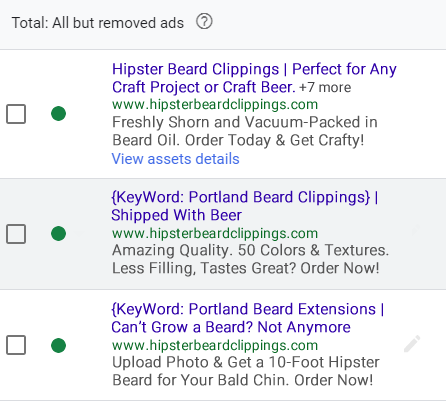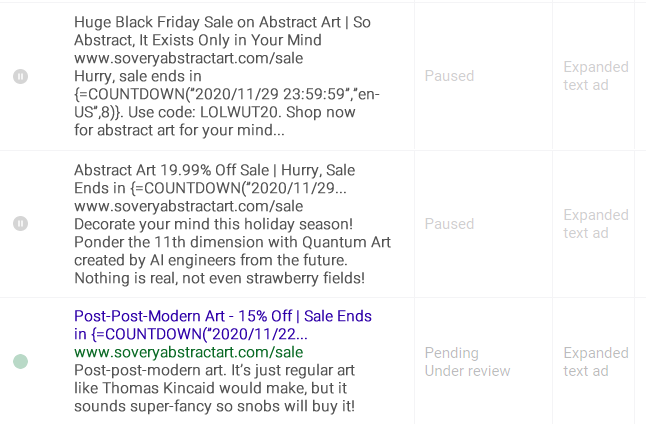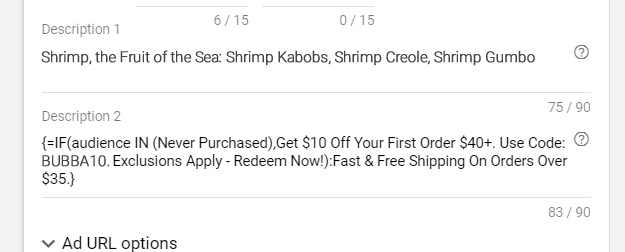
By virtue of campaign structure – ideally a structure that is well-categorized, thematic, or “granular” – PPC ads are supposed to be highly relevant to the keyword search performed by a user. In a way, we consider these ads to be inherently personalized, even if we don’t know a great deal about the user.
But that’s only a baby step along the way towards the promise of richer personalization. Moreover, trying to achieve it all through campaign structure alone can lead to unwieldy workflow and hard-to-assess (smaller) buckets of data.
Google kicked off the idea of dynamic, adjustable ad copy a long time ago when they rolled out Dynamic Keyword Insertion (DKI). This by-now basic technique allowed us to insert the user’s query into the headline or body copy. It’s often worth a try – for example, when adgroups are based on long lists of keywords – and there may be a benefit to matching the user’s exact query in the headline or body copy. The Default text (after the colon) is shown only when the query won’t fit or is otherwise unsuitable for insertion.
In general, Google’s research has shown that headlines that more closely match queries tend to generate higher CTR’s and presumably a higher perception of relevance on the searcher’s part. The Ad Relevance component of Quality Score might even get an added bump from this closeness, over and above the Expected CTR component of Quality Score. Furthermore, the notion of “query leads to relevant ad which then leads to a landing page that contains similar words and concepts” squares with the legendary User Experience principle of “information scent,” and might once again be associated with a higher Ad Relevance score.
There are few hard-and-fast rules in our PPC lab. Although not an imperative, dynamic customization seems like an ad element worth testing often.

Figure 1: Example of testing the efficacy of Dynamic Keyword Insertion, an early form of Ad Customizer rolled out by Google.
Here are three other interesting uses for Ad Customizers.
1. Countdown Ads
Countdown ads are very popular. These are used for limited-time promotions (or whenever there is a deadline or time-sensitivity). Set a couple of parameters, including the expiry date, marry those with appropriate text, and now a searcher may see that a sale ends in (say) a few hours, or two days. Since it’s automated, there’s no need to update the ads.
A colleague of mine has a pretty elaborate way of laying these out, including setting up multiple versions to try to coax Google into incorporating more of these ads into the rotation on a short timeframe. But the important thing is that you experiment with these and figure out whether they’re useful and worth your time. We regularly perform post-mortem reviews to ensure that the results attributed to these ads actually make them worth running. Remember, promotions that consumers are made aware of on the website, via email, or on other channels like Facebook or Display, don’t lose their effectiveness entirely just because you refrain from incorporating Countdown Ads in a PPC adgroup. Consider it a means of being thorough, and, in keeping with our lab metaphor around here, a data point worth subjecting to numerous experiments.

Figure 2: An example of Countdown Ads being tested. Disguised to protect privacy.
2. If-then statements being used to offer discounts
All ad customizers are built on “low-code” methods to allow non-technical users to insert dynamic messaging based on certain variables. Previously, we’ve discussed the variables of user query input and time left before a promotion ends. In this case, we want new customers to be offered a discount code without showing it to existing customers. That’s fair ball – it’s an introductory offer, after all. Using some handy rulesets in Google’s arsenal, we can identify an audience that we’ve imported (a custom audience from our Analytics platform) that indicates a new customer (“Never Purchased”). That user gets wind of the discount code while everyone else sees the default text instead. (Or, consumers could just use the Honey app to figure out good discount codes on an ongoing basis, but I digress.)

Figure 3: For your eyes only, a discount.
3. Insert name of country
It can be unwieldy to set up many campaigns to account for factors like geography, but in e-commerce outside of the USA, there is a heightened importance to customize messaging to each country. Let’s say we ship a high-margin product for free (our hypothetical client absorbs the shipping cost, as the average Lifetime Value of their hypothetical customer is $900) to 58 countries, but people who live in Hong Kong and Turkey often have serious doubts about whether the message is tailored to them and whether they will incur hefty shipping costs. Our ad customizer was used to reassure those consumers that shipping was free in their country. Our data show this style of ad to be effective, especially as we’re aware that many searchers add their country name to a search query specifically wanting to find vendors who have an offering tailored to their home country. The Customizer part looks like this:
{=TargetLocation.Location:Free Shipping on All Orders}
I hope you found those examples useful. Happy customizing! Just remember not to go too crazy. Return on time spent, and all.
Speaking of time spent, egads, time for my lunch! Vietnamese noodles ☺.
Read Part 31: Why Mature Advertisers Should Flee GDN